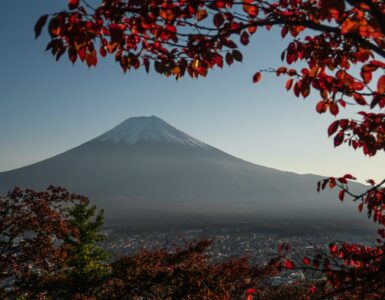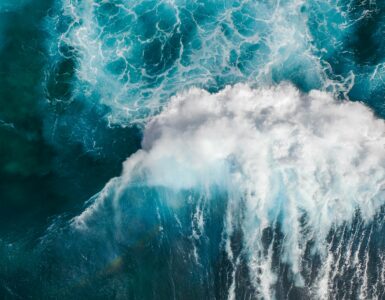Erosion is the removal and transportation of the earth’s surface material such as broken soil, rocks, and debris by water, wind, and ice. Natural elements like water, glacier, and wind wear out the earth’s crust and transport the loose materials from one location to another. Erosion is also known as the washing away of topsoil. It’s a gradual process like weathering but quite different. It is a complex process that involves the detachment of earth surface material, transportation, and eventual deposition.
Types of Erosion
Several types of erosion occur in different regions. Under each type, there are certain sub-categories.
Water Erosion
Water erosion is caused by rainfall and water flow. Rainfall loosens the soil and moves surface soil across a distance. Heavy rains result in large bodies of water that move the topsoil in large quantities. It is also caused by rivers, lakes, and floods. These agents of water erosion disintegrate and wash away soil and rocks sediments.
Rainfall Erosion
Rainfall leads to three types of erosion.
- The Splash Erosion
Splash erosion often breaks down the soil. It is a result of the impact of raindrops on the soil. Raindrops can break down topsoil up to a depth of 5-6 meters. Splash erosion initiates the erosion process as the force from raindrops breaks down the soil and makes it easy to wash off by flood.
- Sheet Erosion
Sheet erosion is caused by flowing water. After the effect of raindrops on the soil, flowing water leads to the removal of loose sediment. It is shallow and affects soil and rock particles at the surface level.
- Rill Erosion
Rill erosion is the movement of soil by a stream-like body of water. When water creates a channel in the soil, more of the soil is removed. Rill erosion occurs when sizeable body water washes away the topsoil at an increased velocity. It is more intense compared to sheet erosion as it goes deeper than the surface level.
- Gully Erosion
Gully erosion is the removal of sizable soil, rocks, and debris by a concentrated body of water along drainage lines. It leads to the formation of a landform known as a gully. Gullies become deep over time as the action of water removes both side and bottom soils.
- Tunnel Erosion
In tunnel erosion, the subsoil is displaced by the movement of water through the cracks of the soil. This leaves behind a tunnel shape after continuous washing away. The cracks in the soil become bigger due to the continuous movement of water through it and this may lead to a gully if a large body of water washes away the soil on top. Tunnel erosion affects mostly soils with a high quantity of sodium(Sodosols).
Other Types of Water Erosion
Valley Erosion – occurs when large bodies of water remove soil and debris from their banks. Rivers, streams, and oceans constantly wash away the soil at their banks leading to the formation of a larger area.
Wind Erosion
Wind erosion is the removal of surface soil by the force of the wind. The wind is an agent of erosion. In arid and semi-arid regions, the wind is a crucial geomorphological agent. Wind moves sands at high speed and in great quantities. The wind can move sand at high speed and at an elevation of 400 meters or higher.
In wind erosion, a term known as deflation is used to describe the action of the wind when it removes loose topsoil and particles. In deflation, there is a movement known as surface creep. Surface creep occurs when large soil particles roll on the ground due to the force exerted by the wind.
Saltation is another type of deflation that involves the movement of small soil particles in the air at a certain height. These slightly elevated particles bounce across a plain.
Suspension is the third type of deflation. In suspension, small and light materials are raised aloft and moved over a long distance.
Abrasion is another major type of wind erosion like deflation. Abrasion occurs when soil particles carried by the wind strike surfaces, leading to a gradual breakdown of surfaces such particles strike while in motion.
In dry regions, wind erosion causes the breakdown of soft rocks as small particles lifted by the wind strike such rock repeatedly. This action leads to the breakdown of rocks with soft layers.
Ice Erosion
Ice erosion is caused by large bodies of ice known as glaciers. Glaciers with the help of gravity wear out a surface and shape a landform. Glaciers flow down a slope and in the process move sands and rocks along the way.
Ice or glacier erosion works in three ways.
Abrasion
Abrasion is also known as scouring. It refers to the process of sediment freezing with glaciers and thereby wearing away surfaces as the glaciers move. It’s an action that causes the surfaces a glacier moves over to wear away.
Plucking
Plucking, also known as quarrying, is the movement of pieces of bedrocks that cause friction thereby making basal ice melt and penetrating cracks in the surface bedrocks. The freezing and melting of the ice lead to more cracks.
Melt Water
The base of a glacier has a stream of water from it. This stream of water causes erosion the same way water from a river does. Since water from ice is heavy, the surface soil moved is enormous.
Mass Movement
Mass movement is caused by gravitational force which induces sediment and rocks to move downwards from a slope. It moves material from a high position to low areas. A mass movement can be slow or sudden with disastrous results.
For example, slumping occurs on steep hillsides where materials like clay move down the hill. Generally, the movement of earth or soil particles, either fast or slow, soft clay or heavy boulders, are sometimes classified as landslides.
Factors Affecting Erosion Occurrence
Climate
Climate influences erosion through rainfall. Climate determines the amount of rainfall as well as the intensity. Both factors greatly affect erosion as rainfall intensity leads to splash erosion and the volume of water causes sheet or gully erosion. When heavy precipitation occurs in places with little to no vegetal cover, the erosion by water is usually intense.
In certain climates where precipitation is usually low, the vegetation in such regions is little. Hence, wind erosion can adversely affect the dry and exposed soil.
Temperature is another factor that affects vegetation and the soil. The temperature has a bearing on the properties of soil and vegetation. It influences the strength of the soil.
Topography
The topography of any landmass is a factor that determines the magnitude of erosion that occurs. A land area with steep slopes experiences a high rate of erosion and landslides. When steep slopes have no vegetation, the effect is more severe.
Human Action
Human action is one of the factors influencing erosion. In the process of development, vegetation is removed to accommodate structures. Urban development represents one of the human actions that cause soil erosion of all kinds in certain circumstances. Agricultural activities cause the topsoil to shift. Eventually, the soil becomes exposed to water erosion. In some regions of the world, animals are allowed to graze openly on vegetation. This type of uncontrolled grazing leads to the loss of vegetation and leaves the soil bare and susceptible to water and wind erosion majorly. Human action is considered one of the primary factors.
Vegetation
The vegetal cover serves as a protective layer for the soil. Vegetation reduces runoff and the action of the wind. The root of the plants interlocks well with soil to create a firm resistance against the force of wind or that of water. The lack of vegetal cover exposes the soil to wind and water erosion.
Tectonic Action
Tectonic actions elevate or lower the surface of the earth. Since erosion is facilitated by land topography, when tectonic actions lower a plain, the land areas are affected by erosion. This also affects rocks that are raised by tectonic actions. Such rocks are exposed to the action of erosion, be it water or wind.
Erosion Control
Erosion can be controlled to avoid adverse effects. Control techniques can be Natural or artificial.
Natural Control
The windbreak technique is a natural way to mitigate wind erosion. It involves planting trees to protect lands from erosion. A riparian buffer is a similar technique that includes planting vegetation near a stream or river to reduce the impact of water erosion on nearby land areas.
Artificial Control
Gabions are installed as artificial means of controlling erosion. It involves the use of huge wireframes to hold boulders in place. The boulders protect land areas close to any body of water from erosion.





Add comment